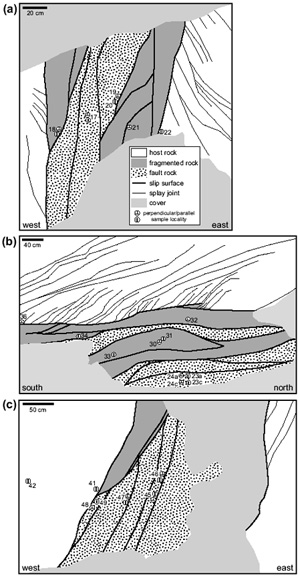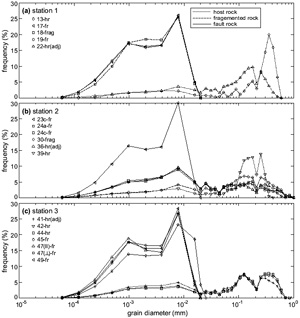| |||||||
|
|
|||||||
|
|
|||||||
| Grain Size Distribution of Sheared Joint-based Faults | |||||||
|
A subset of faults formed by shearing of joints and joint zones in Jurassic Aztec Sandstone exposed at Valley of Fire State Park, Nevada, was investigated by Flodin (2003) and Flodin et al. (2005). The first two stations (stations 1 and 2) were located within a fault zone with 25 m left-lateral slip (Figure 1a and Figure 1b) and the third station (sample 3) from a fault zone with 160 m left-lateral slip (Figure 1c). Grain size distribution from samples collected from various components of the fault zones (fragmented rocks and fault rocks) as well as the adjacent host rocks were measured using laser particle size analysis, which has lower and upper detection limits of 0.04 and 2000 um, respectively. As shown by the plots in Figure 2 (a, b, and c), the grain size distributions are bimodel and the fault with the greater slip magnitude shows greater communition. Host rock samples adjacent to the faults possess lower median grain sizes (48-139 µm) than host rock samples collected away from the faults. Three host rock samples (41, 42, 44) from station 3 show a trend for smaller median values and decreased sorting with proximity to the fault core (Figure 2c). There is a trend of reduction in median grain size from host rock (between 160 and 332 µm) to fragmented rock to fault rock (between 3 and 51 µm). In most cases, fault rock grain sizes span a much narrower range (between 0.06 and 20 µm) with respect to host rock samples (0.06 and 840 µm). The authors noted a lower limit of grain size reduction for fault rock samples irrespective of average shear strain. Data from studies concerning fragmentation and grain size reduction associated with other faulting mechanisms, or faults with unspecified mechanisms are provided at other places in this Knowledgebase. In a study of deformed crystalline rocks cored from active faults related to the San Andreas system of southern California, Blenkinsop (1991) provided a conceptual model for grain size reduction associated with dilatant fractures or cataclastic faults. Please see the link, 'Grain Size Distribution of Cataclasis in Dynamic Faulting.' | |||||||
| Reference: |
|||||||
| Blenkinsop, T.G., 1991 Crawford, B.R., 1998 Engelder, T., 1974 Flodin, E.A., 2003 Flodin, E.A., Gerdes, M., Aydin, A., Wiggins, W.D., 2005 Mair, K., Main, I., Elphick, S., 2000 Marone, C., Scholz, C.H., 1989 Sammis, C.G., Osborne, R.H., Anderson, J.L., Badert, M., White, P., 1986 Shipton, Z.K., Cowie, P.A., 2001 |
|||||||
|
Readme | About Us | Acknowledgement | How to Cite | Terms of Use | Ⓒ Rock Fracture Knowledgebase |
|||||||

